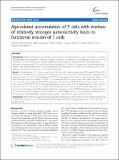Age-related accumulation of T cells with markers of relatively stronger autoreactivity leads to functional erosion of T cells
Author(s)
Tatari-Calderone, Zohreh; Stojakovic, Milica; Dewan, Ramita; Le Bouder, Gama P.; Jankovic, Dragana; Vukmanovic, Stanislav; ... Show more Show less
Download1471-2172-13-8.pdf (2.924Mb)
PUBLISHER_CC
Publisher with Creative Commons License
Creative Commons Attribution
Terms of use
Metadata
Show full item recordAbstract
Background Thymic involution is a prominent characteristic of an aging immune system. When thymic function is reduced/absent, the peripheral T cell pool is subject to the laws of peripheral T cell homeostasis that favor survival/expansion of T cell receptors with relatively higher functional avidity for self-peptide/MHC complexes. Due to difficulties in assessing the TCR avidity in polyclonal population of T cells, it is currently not known whether high avidity T cells preferentially survive in aging individuals, and what impact this might have on the function of the immune system and development of autoimmune diseases. Results The phenotype of T cells from aged mice (18-24 months) indicating functional TCR avidity (CD3 and CD5 expression) correlates with the level of preserved thymic function. In mice with moderate thymic output (> 30% of peripheral CD62Lhi T cells), T cells displayed CD3lowCD5hi phenotype characteristic for high functional avidity. In old mice with drastically low numbers of CD62Lhi T cells reduced CD5 levels were found. After adult thymectomy, T cells of young mice developed CD3lowCD5hi phenotype, followed by a CD3lowCD5low phenotype. Spleens of old mice with the CD3low/CD5hi T cell phenotype displayed increased levels of IL-10 mRNA, and their T cells could be induced to secrete IL-10 in vitro. In contrast, downmodulation of CD5 was accompanied with reduced IL-10 expression and impaired anti-CD3 induced proliferation. Irrespective of the CD3/CD5 phenotype, reduced severity of experimental allergic myelitis occurred in old mice. In MTB TCRβ transgenic mice that display globally elevated TCR avidity for self peptide/MHC, identical change patterns occurred, only at an accelerated pace. Conclusions These findings suggest that age-associated dysfunctions of the immune system could in part be due to functional erosion of T cells devised to protect the hosts from the prolonged exposure to T cells with high-avidity for self.
Date issued
2012-02Department
Sloan School of ManagementJournal
BMC Immunology
Publisher
BioMed Central Ltd
Citation
Tatari-Calderone, Zohreh et al. “Age-related Accumulation of T Cells with Markers of Relatively Stronger Autoreactivity Leads to Functional Erosion of T Cells.” BMC Immunology 13.1 (2012): 8.
Version: Final published version
ISSN
1471-2172